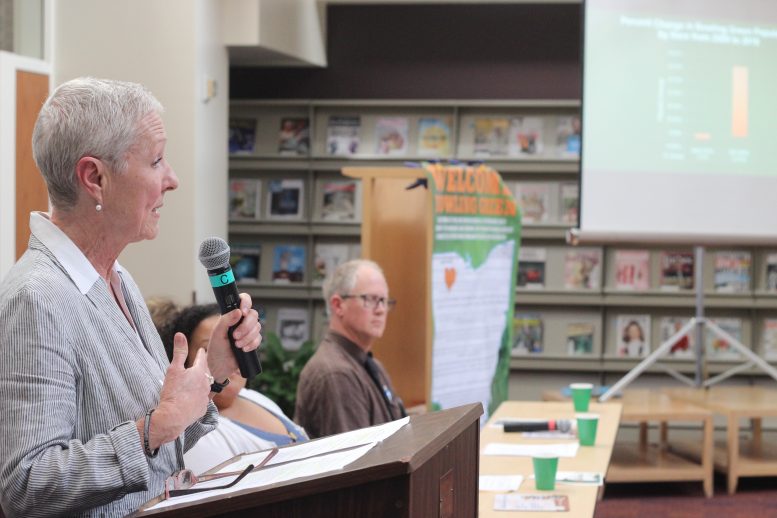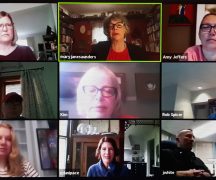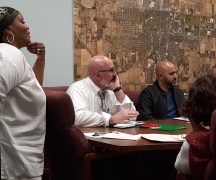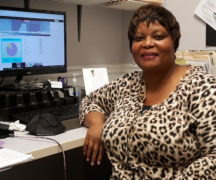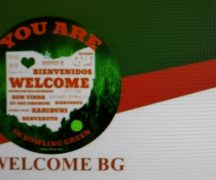By DAVID DUPONT
BG Independent News
The community conversation on how to make the city’s Welcome BG promise a reality had a lot of aspirations and some practical goals. It also had a number of reminders that for some people Bowling Green has a long way to go.
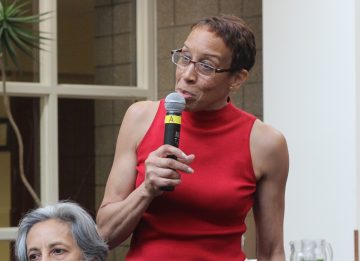
Judith Jackson May
The focus often is on welcoming immigrants. Judith Jackson May, who teaches at the university, though, said she was born in the city, grew up here. Still as a black woman when she goes into Walmart she’s always followed. She wonders why they think she’s going to steal something. And she stopped shopping at Kroger because of the unfriendly attitude she faced there.
She loves her walk to work every morning, except for the black jockey figure decorating the lawn of a home on Haskins Road. And she and her husband seem to get stopped by police a lot.
Still May said she loves Bowling Green. There’s something that keeps her there.
Nicolas Cabanillas, who is of Hispanic descent, echoed May’s love of his hometown. Still as he’s walking, trucks will pull up next to him and then accelerate so then vehicle spews exhaust.
Melba Conway, who recently moved here, said she’s been struck by how whatever activity she attends, whether a Tai Chi class or a service club meeting, all the faces she sees are white like hers.
That lack of diversity, she said, leads to casual expressions of racism like a sign in the library’s women’s room that offered diapers “for those in need.” The baby depicted is black. Why associate the child “in need” as black, she wondered.
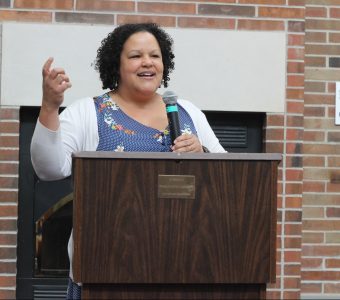
Christina Lunceford
Christina Lunceford, a special assistant to president for diversity at BGSU, said that the university needs to recruit a diverse faculty. Students are being educated as global citizens and need faculty who represent that reality. Those faculty are encouraged to live in Bowling Green. People want to live in a community where they can be engaged, she said
Still, she said: “We have to be realistic. We still have a lot of work to do.”
Being more welcoming to people of all backgrounds is more than good intentions, it’s an economic reality.
Margaret Montague, of the Welcome BG Task Force, spelled out the demographic trends.
The population of Bowling Green is at once growing older, and at the same time growing more diverse.
Sue Clark, executive director of the BG Community Development Foundation, said that there’s an increasing shortage of workers. There are 9,200 jobs ranging from laborers to engineers available within 20 miles of Bowling Green. With the unemployment rate declining, those jobs get harder to fill, and when they are the newly hired workers often quit within a week.
Clark said the task force recommends connecting employers with “identified labor pools” – millennials, international students, immigrants, and refugees.
That could involve helping with refugee resettlement, sponsoring international students so they can work while here, and “advocating for meaningful immigration reform and Dream Act.”
It also means working with immigrant entrepreneurs.
Many international students who come to study here, are interested in staying, Lunceford said.
Such an approach would be consistent with the country’s and the region’s immigrant tradition, Montague said.
City Council member Bruce Jeffers spoke to the quality of life issues. The city needs to provide adequate affordable housing, he said, as well as improve its public transportation.
That’s not just important for international students, Lunceford said, but for students who come from urban areas where they don’t have cars.
Susana Pena, director of the School of Cultural and Critical Studies, said that transportation is more than getting to work. It’s getting to the doctor, and being able to pick up a sick child. It’s a great problem for people who don’t have transportation or cannot get a license because of they lack proper immigration documentation.
Jeffers said another important aspect of livability is safety. That means, in part, “we don’t want our police to be overly concerned with people’s immigration status.”
People shouldn’t be afraid to report a crime or testify because they’re afraid they’ll be deported. If they are, he said, that makes a community less safe.
When someone who would not give her full name in the audience called Immigration and Custom Enforcement “a terrorist group supported by the state.”
Police Chief Tony Hetrick said he has have very few interactions with ICE in the 22 years he’s been in Bowling Green. One recent incident involved a former BGSU international student who had overstayed his visa. He was harassing people and acting irrationally. He was also going to Findlay to use a firing range.
Hetrick said he not only called ICE, he also called in the FBI.
But, he said, his department does not report people’s immigration status to ICE.
Beatriz Maya, the director of La Conexion, one of the sponsors of the event, praised the BG police, saying they were concerned with public safety.

